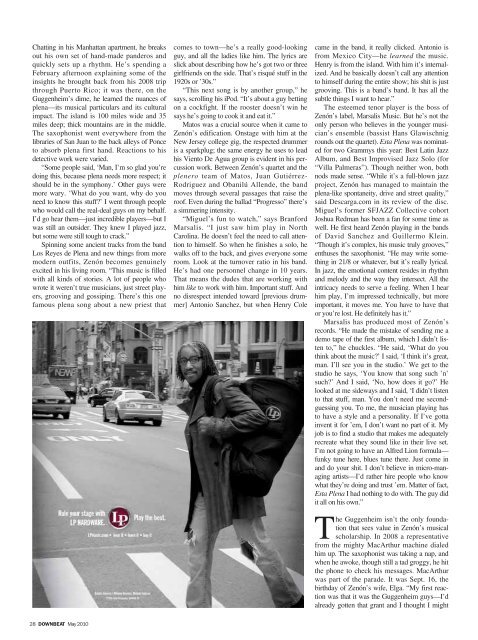Download - Downbeat
Download - Downbeat
Download - Downbeat
- No tags were found...
You also want an ePaper? Increase the reach of your titles
YUMPU automatically turns print PDFs into web optimized ePapers that Google loves.
Chatting in his Manhattan apartment, he breaksout his own set of hand-made panderos andquickly sets up a rhythm. He’s spending aFebruary afternoon explaining some of theinsights he brought back from his 2008 tripthrough Puerto Rico; it was there, on theGuggenheim’s dime, he learned the nuances ofplena—its musical particulars and its culturalimpact. The island is 100 miles wide and 35miles deep; thick mountains are in the middle.The saxophonist went everywhere from thelibraries of San Juan to the back alleys of Ponceto absorb plena first hand. Reactions to hisdetective work were varied.“Some people said, ‘Man, I’m so glad you’redoing this, because plena needs more respect; itshould be in the symphony.’ Other guys weremore wary. ‘What do you want, why do youneed to know this stuff?’ I went through peoplewho would call the real-deal guys on my behalf.I’d go hear them—just incredible players—but Iwas still an outsider. They knew I played jazz,but some were still tough to crack.”Spinning some ancient tracks from the bandLos Reyes de Plena and new things from moremodern outfits, Zenón becomes genuinelyexcited in his living room. “This music is filledwith all kinds of stories. A lot of people whowrote it weren’t true musicians, just street players,grooving and gossiping. There’s this onefamous plena song about a new priest thatcomes to town—he’s a really good-lookingguy, and all the ladies like him. The lyrics areslick about describing how he’s got two or threegirlfriends on the side. That’s risqué stuff in the1920s or ’30s.”“This next song is by another group,” hesays, scrolling his iPod. “It’s about a guy bettingon a cockfight. If the rooster doesn’t win hesays he’s going to cook it and eat it.”Matos was a crucial source when it came toZenón’s edification. Onstage with him at theNew Jersey college gig, the respected drummeris a sparkplug; the same energy he uses to leadhis Viento De Agua group is evident in his percussionwork. Between Zenón’s quartet and theplenero team of Matos, Juan Gutiérrez-Rodriguez and Obanilú Allende, the bandmoves through several passages that raise theroof. Even during the ballad “Progresso” there’sa simmering intensity.“Miguel’s fun to watch,” says BranfordMarsalis. “I just saw him play in NorthCarolina. He doesn’t feel the need to call attentionto himself. So when he finishes a solo, hewalks off to the back, and gives everyone someroom. Look at the turnover ratio in his band.He’s had one personnel change in 10 years.That means the dudes that are working withhim like to work with him. Important stuff. Andno disrespect intended toward [previous drummer]Antonio Sanchez, but when Henry Colecame in the band, it really clicked. Antonio isfrom Mexico City—he learned the music.Henry is from the island. With him it’s internalized.And he basically doesn’t call any attentionto himself during the entire show; his shit is justgrooving. This is a band’s band. It has all thesubtle things I want to hear.”The esteemed tenor player is the boss ofZenón’s label, Marsalis Music. But he’s not theonly person who believes in the younger musician’sensemble (bassist Hans Glawischnigrounds out the quartet). Esta Plena was nominatedfor two Grammys this year: Best Latin JazzAlbum, and Best Improvised Jazz Solo (for“Villa Palmeras”). Though neither won, bothnods made sense. “While it’s a full-blown jazzproject, Zenón has managed to maintain theplena-like spontaneity, drive and street quality,”said Descarga.com in its review of the disc.Miguel’s former SFJAZZ Collective cohortJoshua Redman has been a fan for some time aswell. He first heard Zenón playing in the bandsof David Sanchez and Guillermo Klein.“Though it’s complex, his music truly grooves,”enthuses the saxophonist. “He may write somethingin 21/8 or whatever, but it’s really lyrical.In jazz, the emotional content resides in rhythmand melody and the way they intersect. All theintricacy needs to serve a feeling. When I hearhim play, I’m impressed technically, but moreimportant, it moves me. You have to have thator you’re lost. He definitely has it.”Marsalis has produced most of Zenón’srecords. “He made the mistake of sending me ademo tape of the first album, which I didn’t listento,” he chuckles. “He said, ‘What do youthink about the music?’ I said, ‘I think it’s great,man. I’ll see you in the studio.’ We get to thestudio he says, ‘You know that song such ’n’such?’ And I said, ‘No, how does it go?’ Helooked at me sideways and I said, ‘I didn’t listento that stuff, man. You don’t need me secondguessingyou. To me, the musician playing hasto have a style and a personality. If I’ve gottainvent it for ’em, I don’t want no part of it. Myjob is to find a studio that makes me adequatelyrecreate what they sound like in their live set.I’m not going to have an Alfred Lion formula—funky tune here, blues tune there. Just come inand do your shit. I don’t believe in micro-managingartists—I’d rather hire people who knowwhat they’re doing and trust ’em. Matter of fact,Esta Plena I had nothing to do with. The guy didit all on his own.”The Guggenheim isn’t the only foundationthat sees value in Zenón’s musicalscholarship. In 2008 a representativefrom the mighty MacArthur machine dialedhim up. The saxophonist was taking a nap, andwhen he awoke, though still a tad groggy, he hitthe phone to check his messages. MacArthurwas part of the parade. It was Sept. 16, thebirthday of Zenón’s wife, Elga. “My first reactionwas that it was the Guggenheim guys—I’dalready gotten that grant and I thought I might28 DOWNBEAT May 2010
















